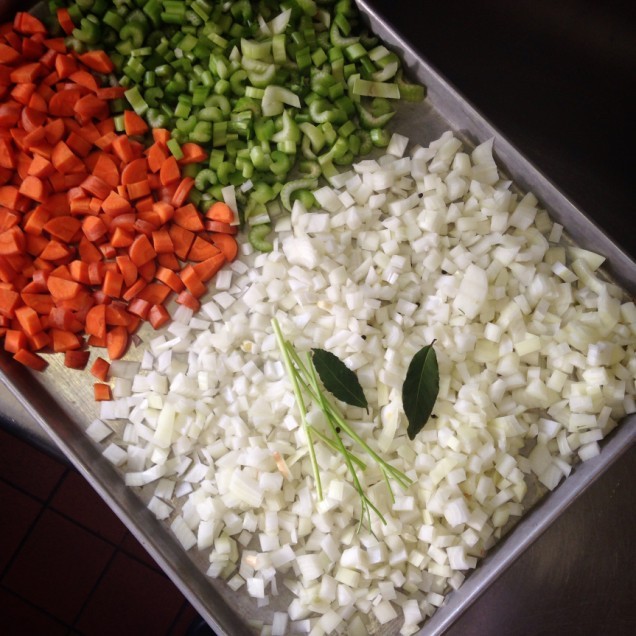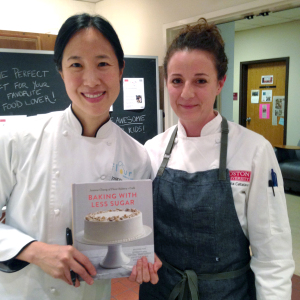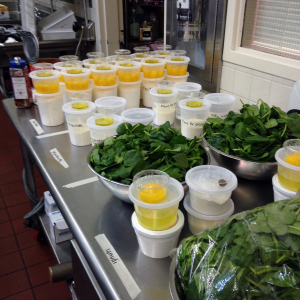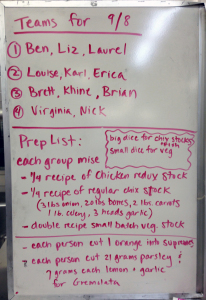The Meaning of Mise-en-Place
by Claudia Catalano

One of the first lessons students learn in culinary school is the meaning of mise-en-place. French for “put in place”, it means that ingredients are prepped, tools are gathered, and everything is organized before cooking begins. It’s a grounding philosophy that keeps your head clear and your body poised to make things happen.
After almost a year in the BU kitchen, I have become intimately familiar with the concept. As part of my Gastronomy degree, I completed the Culinary Certificate program last spring, and was honored to be awarded the Julia Child teaching assistant position for the Fall 2015 semester. From September to December (that flew by), I fastidiously ‘mise-en-placed’ my way through veal stocks, bread dough, handmade pasta, fresh ricotta, Thai green curry, Punjabi greens, tres leches cake and much, much more. I gathered produce for daily recipes, measured ingredients for morning demonstrations, peeled, seeded and chopped tomatoes, and washed caseloads of chicken backs for the stockpot. My corner of the kitchen was rarely without a project.

The organizational philosophy extended beyond my personal workspace and into big-picture planning. I’d review recipes for upcoming classes and make ingredient lists of things we were missing. To prepare for public events like Anson Mills with Barry Maiden, the MET gala honoring Jacques Pépin, ricotta-making with Mary Ann Esposito, and low-sugar baking with Joanne Chang, I’d start collecting and categorizing special supplies days in advance. When it came time to assist our visiting chefs during demonstrations, the mise-en-place mentality was at its height. I knew each recipe inside and out—not just how much of each ingredient, but the process, the timing, and desired outcome of each step. I’d stand in the wings and swoop in to remove an empty vessel, or to hand over a whisk seconds before the chef even realized she needed it. Like a ball boy at Wimbledon, I was always ready with one foot pivoted toward the action.
For me, the first few weeks as the TA was like a proving ground to show what I’d learned as a student. Did I retain those visual cues that tell you when pâte à choux is ready to be piped? Did I remember how to filet a flat fish versus a round? What’s the ideal temperature for roasting a chicken? Students often looked to me for advice and my cooking knowledge (or lack thereof) was a direct reflection of the instructors’ ability to teach.

One of the first real tests came when the class was learning the art of sauce-making from chef Michael Leviton. The students were focused on their salsa verde and red wine reduction, while I was tasked with cooking some steaks for them to taste with. Cooking steaks for Leviton, the precision-obsessed, James Beard nominated chef who taught his very specific technique to me the previous semester—no big deal. Slightly nervous, but excited for the challenge, I gathered my mise-en-place. Three thick sirloins, a squeeze bottle of oil, kosher salt, fresh ground pepper, tongs, a half-sheet tray with a rack, a digital instant-read thermometer, and a plate for serving were all within arms reach. Don’t screw this up, I thought. Don’t screw this up!
I performed the task exactly as I remembered, first searing and basting in a hot pan, then resting on a rack, finishing in a 300-degree oven and resting again until the internal temperature reached 130 degrees—perfect medium-rare.
I carried the plate to the front of the class where students were gathered to hear the chef talk about the precision and finesse required to properly cook meat. That it’s not just about a flaming hot grill. That a charred exterior and blood-red interior are not desired outcomes. That many cooks get this wrong.
Confident, but not completely sure of what his knife would reveal, I stood sheepishly off to the side, contemplating escaping to the bathroom in lieu of being mortified by my imperfect steak. But as he sliced through with neat, angled cuts, he proudly proclaimed, “this is exactly what you’re looking for”.
I breathed a sigh of relief and I’m sure he did too. That evening I came home from school feeling like a rock star.

The culinary program changed my approach to cooking. I not only learned to keep my head clear and my space organized, I learned to work with a sense of urgency, to pay close attention to the sharpness of my knives, and to be in tune with all my senses. But most importantly, it taught my something valuable about myself—that I am happiest when working with my hands to create things. As Gastronomy students, the physical labor of cooking is something we study through an academic lens. We observe, research, analyze, and put words on a page in an effort to contribute something to the world. What I’ve realized is that my academic studies combined with my culinary training have given me the gift of knowing what it’s like to be truly engaged and fulfilled.
I look at my years in the Gastronomy program as the mise-en-place for my new career. My personal space is now fully equipped with writing skills, historical context, cultural awareness, kitchen know-how, and a broadened worldview. This spring I will graduate and inevitably be faced with the question “what are you going to do?” I may not have a precise answer, but I know I’m poised to make something happen.
———
Claudia Catalano has been pursuing a degree in Gastronomy since 2012. Formerly a design and brand consultant, she now contributes stories, recipes, and photographs to The Boston Globe food section. She occasionally works as a cook and instructor for the BU Food & Wine and Cooking Up Culture programs. She will graduate this spring. This post originally appeared on her personal blog, The Gastronomy Files.